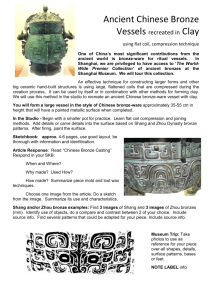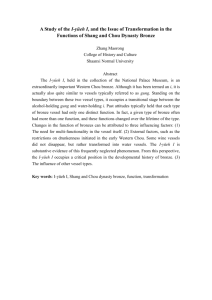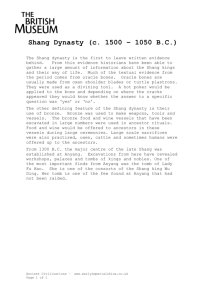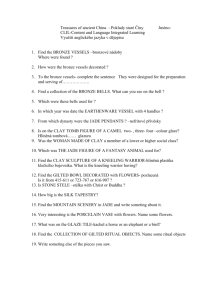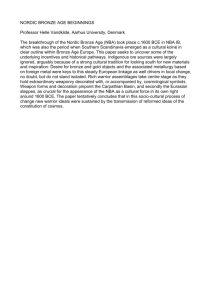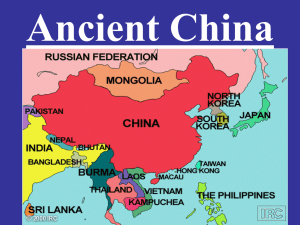Lesson Plans for NCSS Presentation
advertisement
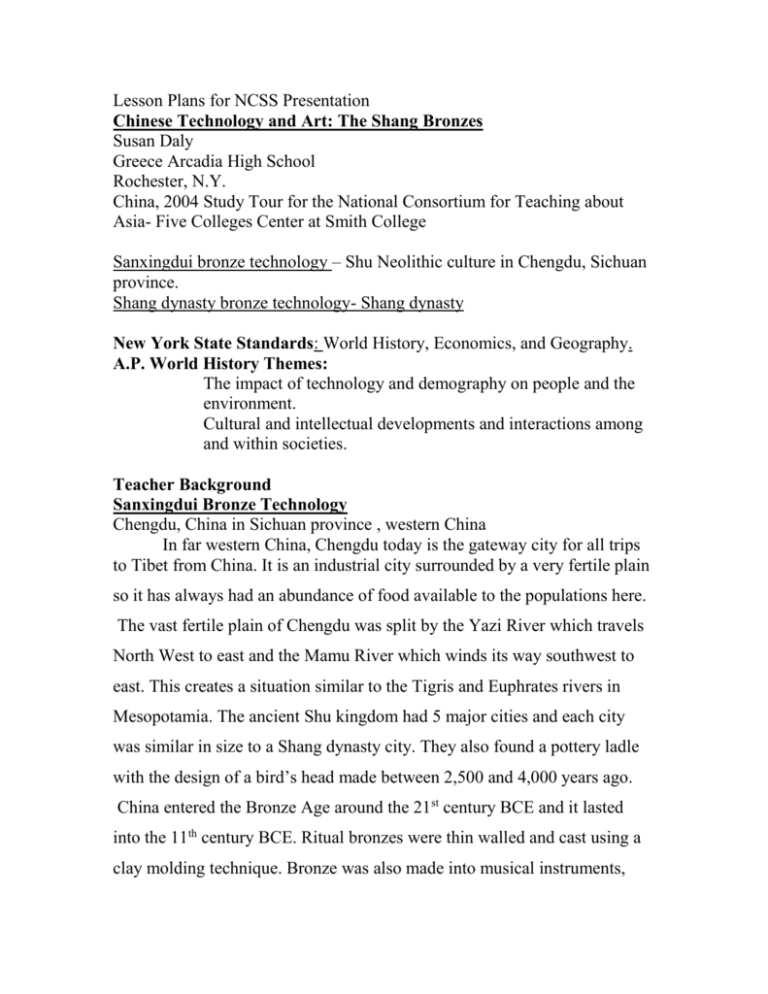
Lesson Plans for NCSS Presentation Chinese Technology and Art: The Shang Bronzes Susan Daly Greece Arcadia High School Rochester, N.Y. China, 2004 Study Tour for the National Consortium for Teaching about Asia- Five Colleges Center at Smith College Sanxingdui bronze technology – Shu Neolithic culture in Chengdu, Sichuan province. Shang dynasty bronze technology- Shang dynasty New York State Standards: World History, Economics, and Geography. A.P. World History Themes: The impact of technology and demography on people and the environment. Cultural and intellectual developments and interactions among and within societies. Teacher Background Sanxingdui Bronze Technology Chengdu, China in Sichuan province , western China In far western China, Chengdu today is the gateway city for all trips to Tibet from China. It is an industrial city surrounded by a very fertile plain so it has always had an abundance of food available to the populations here. The vast fertile plain of Chengdu was split by the Yazi River which travels North West to east and the Mamu River which winds its way southwest to east. This creates a situation similar to the Tigris and Euphrates rivers in Mesopotamia. The ancient Shu kingdom had 5 major cities and each city was similar in size to a Shang dynasty city. They also found a pottery ladle with the design of a bird’s head made between 2,500 and 4,000 years ago. China entered the Bronze Age around the 21st century BCE and it lasted into the 11th century BCE. Ritual bronzes were thin walled and cast using a clay molding technique. Bronze was also made into musical instruments, tools, bells, and personal ornaments. The objects were made during the Shang dynasty between the 16th and 11th centuries BCE. The ruins consist of 6 groups of ruins with a total area of 12 square kilometers. Up to now only 500 meters of the ancient city have been excavated but in these ruins over 100,000 historical relics were found. Stone axes, adzes, shovels, chisels, and spinning wheels. Also pottery articles were found as well as gold and sacrificial jade objects, weapons, tusks of Elephas maximas, and even a walking stick wrapped in gold, emerged from these 2 pits. Numerous bone objects as well as turquoise and ivory objects have also been found here. including high stemmed bowls, cups, jars, basins and even plates. These were fired in an annular kiln with a loose base and some showed that they had not fired long enough. More than 1,000 bronze objects were found but the 6 most unusual were a mask design of a human head, a bronze human head, a bronze human face, a 13 foot tall bronze tree, a bronze object with an animal face, and a gold wrapped walking stick. The society which created these had a King with various clans supporting him, as well as artisans and farmers. Objects started turning up in farmer’s fields in the 1920’s. These included jade bis (round, flat pieces of jade with a hole in them), zhangs (jade tablets), and congs (long hollow pieces of jade with rectangular sides), jade beads and raw jade stones. In 1929, three farmers reported these finds to the government who sent out archaeologists to investigate. Excavations were carried out between 1933 and 1934 and these excavations found more jade objects from the ancient Shu Kingdom In July and August, 1986, two ceremonial pits were discovered. Pits 1 and 2 contained more than 1700 relics including bronze, gold, jade, stone, pottery, amber, and turquoise ornaments. Pit one was dug during the 14th century BCE and Pit two was dug during the 11th century BCE. There were also large numbers of ivory and bone articles and seashells. Most objects had been burned and were badly broken as a result. The largest mask is 60 cm high (24 inches) and 134 cm (54 inches) wide and is the largest face mask ever discovered in China. Its form is a smiling face with 2 very large protruding eyes and large ears sticking out from the face. It may have originally had an ornament on the front because there is a hole over the eyes which cannot be explained otherwise. Some of the masks were covered in gold leaf including one thought to be a sorcerer who would have officiated at the ritual sacrifices here. His head is 45.7 cm (18.2 inches) high by 22.3 cm (8.92 inches) wide. His face looks dignified and his statue is taller than the ungilded ones like it. Altogether 41 bronze human heads were found in the 2 pits. One figure shows a man with his hands holding some object (which is now gone) this figure stands 260 cm (8.6 ft) high with its stand included. Some scholars believe he was once the king of the ancient Shu Kingdom. All of these objects help us to better understand this society and their high level of technological skill with bronze. A museum complex has been built on the ruins to house and highlight these extraordinary objects. Excavations are ongoing in this area. Many images are of very unusual faces with exaggerated features that may look slightly like space aliens to some students. They show an extremely high degree of technological skill. Bronze artifacts were treasured by the Shang and Zhou aristocrats. Many served as ritual offerings to the ancestors and were never used but given as formal gifts to the ancestors as banquet utensils. Ritual bronze of this period were thin walled and cast by a clay piece mould technique. Some vessels are deeply incised with repeating patterns while others are decorated with repeating geometric designs. The bronzes from Sanxingdui are on display at the museum near Chengdu, but other superb examples may be seen in the Shanghai Museum Bronze Gallery. Shang Dynasty Bronze Technology The Shang dynasty in China lasted from 1766 to 1111 BCE and gained control of large areas of northern China. There is disagreement over whether bronze technology developed independently in China but some evidence suggests it did. Chinese bronze craftsmen used an alloy which is peculiar to China and a technique of casting by multiple-piece molds which allowed for unusual complexity in castings. Bronze is an alloy of copper and tin. The Chinese craftsmen added lead to this mixture for their bronzes. The addition of the lead produces the distinctive gray color of many Chinese bronzes. By adding lead to the mixture, the Chinese showed an understanding of smelting metallic oxides. Models were probably first made of clay and then later they may have developed the lost wax method of making bronze. Many Shang dynasty bronzes come from burial sites. The earliest Shang capital was at ZHENGZHOU and it was a walled city with different areas for different craftsmen. There is an extensive burial site at Xiaotun, Anyang (1384-1111BCE) since no dwellings were found here; it may have only been used for royal burials. Early Shang decorations were mainly geometric and arranged in horizontal zones around the vessel. The basic motifs are animal with representations of deer faces, elephant heads, and human heads as well as some mythical animals. Dragons do appear as well as the cicadas whose life cycle represents rebirth and renewal. The 3 legged forms are common although the jue and GU, used for heating wine, disappear fairly early. In the middle Shang period, some vessels contained inscriptions. At this same time, script was being used in divination by writing on bone and then burning it to predict events. These Oracle bones are the earliest written Chinese language. Lesson Suggestions The images from Sanxingdui show the site itself as well as the Museum building in Chengdu which houses this huge collection of objects. The masks are highlighted as is the huge tree which was found in the pits. You could use this to introduce the Bronze Age as a major technological development across the world. Widely separated geographic areas develop bronze technology at different times but it is something that most societies eventually produce. The museum showed how bronze technology was used nearly at the same time in many areas of the world using a map. Unfortunately it was not possible to photograph these due to light conditions. The Shanghai Museum Bronzes are superb examples of Shang technological mastery. Questions to help students relate ritual objects to their experiences. 1. How our society shows honor to a dead relative or friend? 2. What happens when someone dies that allows those relatives left behind to honor their dead relative? 3. Do people bring anything to the home of a family which has had a death? 4. How does our society treat our elected leader? 5. Are their certain symbols which show that our president is a powerful person in this society? (Since I am teaching this content to 6 th or 9th graders, I draw a parallel between the practices which American culture uses to say goodbye to a relative and the burial pits in the Shang dynasty. If students know about ancestor worship, they may also understand that this was and is a common belief in China. ) (Some may have seen the movie, Mulan, which shows the belief in filial piety as the daughter talks to the ancestors before she goes off to war in place of her elderly father.) Although this is clearly before the start of Confucianism, the belief in ancestors goes far back into Chinese history. 6. Ask students why they think a society would go to the trouble of creating these bronze statues only to burn them and bury them in 2 pits. 7. What do these statues indicate about the technological skill developed by this society? 8. What might have been some environmental costs from the development of metal working technology? 9. What is necessary for making bronze of this quality and size? The visual images can reinforce the skill of the ancient Shang dynasty as well as the high level of respect they must have had for their ancestors. If students know about the Old and New Stone ages, they may also know that the development of metal was a large step forward in technology which required a lot of new skills. 10. Is technology always a positive force within a society? You could ask students why they think the faces are so unusual- there are many students who do see these figures as looking like space aliens because of their odd eyes. Point out the braid on the back of the statue whose only is shown. These were all men and this shows that men had long hair which was worn in a braid. Chinese men wore hair like this through much of China’s history. As students study the ancient river valley civilizations , they can look at the Yellow River. This society was actually on a tributary of the Yangtze but could be used to look at similarities and differences between river valley civilizations. Questions to ask students about Bronze Technology 1. How does a society get metal objects ? 2. What materials/ resources are necessary to create bronze? 3. What kind of tools is necessary? 4. What natural resources would need to be found? If you don’t have the needed materials, how could your society get them? 5. Is technological innovation always a positive force in a society? When might it not be? (Weapons) 6. What do these masks teach us about the society which created them? 7. Have they ever seen any masks which look like these? If yes, where were they from? (Some may have seen masks from the Pacific Northwest coast which could remind them of these faces – although they would have been carved out of wood not made of bronze.) 8. What has to develop within any society which is going to produce this much bronze? (Social stratification to allow specialized bronze workers.) 9. What do these figures tell us about the wealth of this society? 10. How could any society support specialized workers such as the bronze workers? 11. Why might this show the importance of ancestor worship within the Shang society? Dear Educators: I took all of the images contained in these Power Points. You may feel free to adapt them as needed for your classes. My trip was sponsored by the National Consortium for Teaching About Asia and was paid for through the Freeman Foundation. I was selected for the summer Study Tour of China in 2004 and these are the result of that trip. I hope you’ll enjoy them and find them useful in your classrooms. Susan Daly my email address is = sdaly2@rochester.rr.com For more information about the National Consortium for Teaching about Asia here is the Contact information = www.nctasia.org
